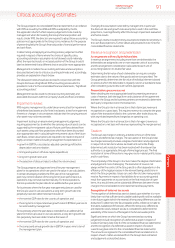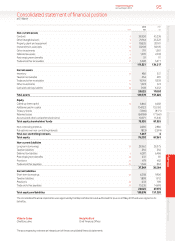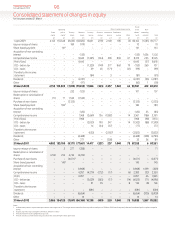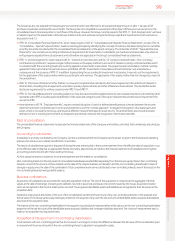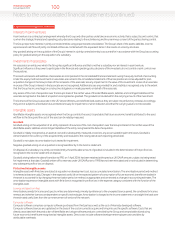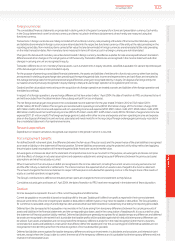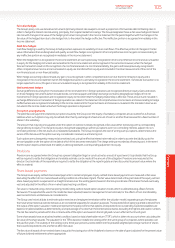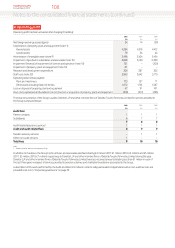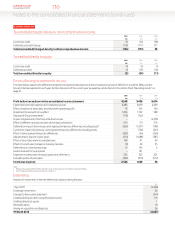Vodafone 2012 Annual Report Download - page 103
Download and view the complete annual report
Please find page 103 of the 2012 Vodafone annual report below. You can navigate through the pages in the report by either clicking on the pages listed below, or by using the keyword search tool below to find specific information within the annual report.
Business review Performance Governance Financials Additional information
101
Vodafone Group Plc
Annual Report 2012
Software integral to a related item of hardware equipment is accounted for as property, plant and equipment.
Costs associated with maintaining computer software programs are recognised as an expense when they are incurred.
Internally developed software is recognised only if all of the following conditions aremet:
a an asset is created that can be separately identied;
a it is probable that the asset created will generate future economic benets; and
a the development cost of the asset can be measured reliably.
Amortisation is charged to the income statement on a straight-line basis over the estimated useful lives from the date the software is available
foruse.
Other intangible assets
Other intangible assets, including brands and customer bases, are recorded at fair value at the date of acquisition. Amortisation is charged to the
income statement , over the estimated useful lives of intangible assets from the date they are available for use, on a straight-line basis, with the
exception of customer relationships which are amortised on a sum of digits basis. The amortisation basis adopted for each class of intangible asset
reects the Group’s consumption of the economic benet from that asset.
Estimated useful lives
The estimated useful lives of nite lived intangible assets are as follows:
a Licence and spectrum fees 3 – 25 years
a Computer software 3 – 5 years
a Brands 1 – 10 years
a Customer bases 2 – 7 years
Property, plant and equipment
Land and buildings held for use are stated in the statement of nancial position at their cost, less anysubsequent accumulated depreciation and
subsequent accumulated impairment losses.
Amounts for equipment, xtures and ttings, which includes network infrastructure assets and which together comprise an all but insignicant
amount of the Group’s property, plant and equipment, are stated at cost less accumulated depreciation and any accumulated impairment losses.
Assets in the course of construction are carried at cost, less any recognised impairment loss. Depreciation of these assets commences when the
assets are ready for their intended use.
The cost of property, plant and equipment includes directly attributable incremental costs incurred in their acquisition and installation.
Depreciation is charged so as to write off the cost of assets, other than land and properties under construction, using the straight-line method, over
their estimated useful lives, as follows:
a Freehold buildings 25 – 50 years
a Leasehold premises the term of the lease
Equipment, xtures and ttings:
a Network infrastructure 3 – 25 years
a Other 3 – 10 years
Depreciation is not provided on freehold land.
Assets held under nance leases are depreciated over their expected useful lives on the same basis as owned assets or, where shorter, the term of
the relevant lease.
The gain or loss arising on the disposal or retirement of an item of property, plant and equipment is determined as the difference between the sale
proceeds and the carrying amount of the asset and is recognised in the income statement.
Impairment of assets
Goodwill
Goodwill is not subject to amortisation but is tested for impairment annually or whenever there is an indication that the asset may be impaired.
For the purpose of impairment testing, assets are grouped at the lowest levels for which there are separately identiable cash ows, known as
cash-generating units. If the recoverable amount of the cash-generating unit is less than the carrying amount of the unit, the impairment loss is
allocated rst to reduce the carrying amount of any goodwill allocated to the unit and then to the other assets of the unit pro-rata on the basis
ofthecarrying amount of each asset in the unit. Impairment losses recognised for goodwill are not reversed in a subsequent period.
Recoverable amount is the higher of fair value less costs to sell and value in use. In assessing value in use, the estimated future cash ows are
discounted to their present value using a pre-tax discount rate that reects current market assessments of the time value of money and the risks
specic to the asset for which the estimates of future cash ows have not been adjusted.
The Group prepares and approves formal ve year management plans for its operations, which are used in the value in use calculations. In certain
developing markets the fth year of the management plan is not indicative of the long-term future performance as operations may not have
reached maturity. For these operations, the Group extends the plan data for an additional ve year period.


